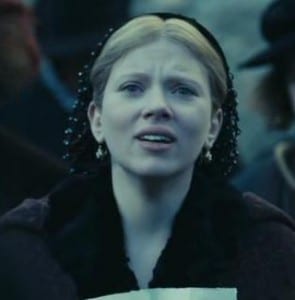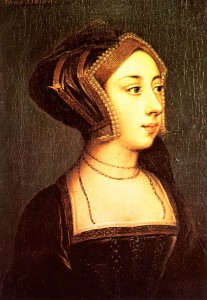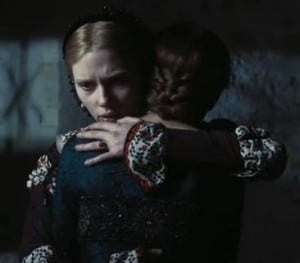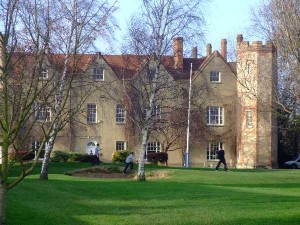
Today we conclude our series on the Boleyn family and our three part series on Mary Boleyn, the other Boleyn girl. Please make sure that you read parts one and two first.
A New Flame
At the Shrove Tuesday joust in 1526, King Henry VIII rode out wearing gold and silver cloth which was embroidered with a picture of a heart in a press surrounded by a flame. The accompanying motto read “Declare ie nose” – “declare I dare not” – and was evidence of a new love in his life, Anne Boleyn.
The pregnant Mary Boleyn had been replaced in the King’s affections by her sister, Anne Boleyn, a woman whom Henry would become so infatuated with that he would break with Rome and set aside his first wife in order to marry her. Mary may have been content with playing mistress but Anne was not willing to be another notch on the royal bedpost and she finally became Queen in 1533. It is ironic that Mary Boleyn had played the role of “kindness” in the Chateau Vert entertainment in 1522 and Anne had played “Perseverance”. Anne certainly needed every ounce of perseverance to hold out for 7 years.
A Widow
In 1528 there was an epidemic of sweating sickness, the first in England since 1485, and it was this disease which took the life of Mary Boleyn’s first husband, Sir William Carey, on the 22nd June 1528. Mary’s siblings, Anne and George, caught the illness but managed to survive, William, however, was not so lucky.
William’s death left Mary in considerable financial difficulty and was driven to asking her former lover, the King, for help. Henry VIII intervened with Mary’s father, Thomas Boleyn, on her behalf and secured some financial help for her. He also granted the wardship of Mary’s son, Henry Carey, to Anne Boleyn, which relieved Mary from the burden of providing for one of her children and also benefited Anne because it gave her the revenues from Henry’s lands which were in her custody until the boy came of age. Towards the end of 1528, Mary was awarded an annuity of £100, an annuity that had previously been granted to her husband.
The years between 1528 and 1532 must have been miserable years for Mary. Wilkinson describes her as “an unwanted and unloved daughter, the discarded mistress”1, but Anne’s rise brought hope in 1532.
Mary and Anne

Josephine Wilkinson writes of how, on the 11th October 1532, Mary accompanied Anne and the King to Calais. This was an important visit because Francis I had offered Henry VIII his support for his proposed marriage to Anne Boleyn and Henry was taking Anne as Marquis of Pembroke and his consort. Anne was expecting to be treated like a Queen. The meeting was a success and it is at this point that Anne and Henry finally consummated their relationship.
At New Year 1533, Mary Boleyn was at court with her sister and is listed as one of the ladies who received New Year’s gifts from the King2 and she gave the King a shirt with a blackwork collar in return, a gift that she had made herself. Wilkinson wonders if Mary was one of the unnamed witnesses who attended Henry and Anne’s secret wedding ceremony on the 25th January 1533. As Anne’s sister and attendant she may well have been part of it and I wonder how she felt seeing her sister marry her former lover. Mary was also present at Anne’s coronation procession, accompanying her mother, Elizabeth Boleyn, in the third coach and wearing a gown of seven yards of scarlet velvet, and at Anne’s coronation ceremony, where she wore a gown of scarlet with an ermine cloak and a bonnet, while she attended on her sister.
Marriage Number Two
The next we hear of Mary Boleyn is a letter written to Lord Lisle in February 1534 by Mary and Sir William Kingston:-
“I desire you and my good lady to be good unto Thomas Hunt, a poor man at Calais, for the room of soldier with 6d. a day in the King’s retinue, when any such is vacant. From the King’s manor of York Place at Westminster, 13 Feb.”3
Josephine Wilkinson writes that Mary’s signature is above Kingston’s on the letter and that suggests that she is the author of it. As you can see, she is asking the help of Lord Lisle, who was in Calais, in finding employment and lodgings for a man named Thomas Hunt. Now, we don’t know who he was but Wilkinson points out that this letter shows that:-
- Mary had links with Calais and that is where her second husband was stationed as a soldier
- Mary may have been part of Anne’s entourage at this time – York Place belonged to Henry VIII and was one of Anne’s favourite residences.
It is interesting that the countersignature belongs to Sir William Kingston, the Constable of the Tower of London and the man who was in charge of Anne Boleyn when she was imprisoned there. He was, however, also a councillor and a friend of Lord Lisle, and Wilkinson believes that he had some kind of family connection to Edward Stafford, the 3rd Duke of Buckingham, who was also related to William Stafford, Mary’s second husband.
The next appearance of Mary in the records is in September 1534, a year after Anne’s coronation and the birth of Elizabeth. A pregnant Mary suddenly appeared at court and announced to her sister that she had got married.4 Josephine Wilkinson writes of how this marriage must have been a love match because Mary had secretly married William Stafford without her family’s knowledge or consent.
William Stafford
William Stafford was born in around 1500 and was an Essex landowner, a soldier in the garrison at Calais and one of Henry VIII’s gentleman ushers. As I have already said, William was a distant relation of Edward Stafford, the 3rd Duke of Buckingham, a man with Plantagenet blood and also a man who was executed for treason in 1521. Stafford was, however, lower in rank than Mary.
It is not known when Mary and William met but he is listed as accompanying the King to France in 1532 and we know that Mary was there too, we also know that Mary kept in contact with Lord Lisle and Calais. William was also present, as one of the “Knights and gentlemen to be servitors”5, at Anne Boleyn’s coronation and he had been at court since 1526. We just don’t know when the couple fell in love, but they married secretly in 1534. Although Mary was pregnant in September 1534, it is not known what happened to that child. It is thought that the couple had two children together, but that they did not survive childhood. Mary’s only surviving children were the two from her first marriage, Catherine and Henry Carey.
William Stafford shared the Boleyn family’s interest in religious reform and he may have met George Boleyn on George’s diplomatic visits to Calais, which George used to make contacts with French Reformers. Wilkinson6 writes that after Mary’s death Stafford was arrested and imprisoned for eating meat on Good Friday and that he and his second wife, Dorothy, were forced into exile in Geneva to escape persecution for their beliefs during the reign of Mary I. It is in Geneva that they met reformer John Calvin who became their youngest son’s Godfather. Of course, we have no evidence of Mary’s beliefs but her father, brother, sister and second husband were all keen reformers so it is likely that she shared their beliefs.
Banishment
In his dispatches of the 19th December 1534, the Imperial Ambassador, Eustace Chapuys, wrote to his master Charles V:-
“The Lady’s sister was also banished from Court three months ago, but it was necessary to do so, for besides that she had been found guilty of misconduct (malefice), it would not have been becoming to see her at Court enceinte [pregnant].”7
Anne was livid at her sister’s scandalous behaviour and banished Mary from court and Mary’s father, Thomas Boleyn, was also angry and cut off his daughter’s allowance leaving Mary to write to Thomas Cromwell for financial help. It is not known whether Cromwell or the King helped Mary this time. Why the fuss? Because not only had Mary married in secret without her family’s permission, but she had also married a man of a lower rank and status and “had undermined Anne’s position by not taking into account the presiding role that the Boleyn family now owed to Anne as Queen.”8 Mary was the Queen’s sister but had not acted as such.
In Letters and Papers, Foreign and Domestic, Henry VIII, there is a record of the letter written by Mary Stafford to Master Secretary, Thomas Cromwell:-
“Desires him to be good to her poor husband and herself. He is aware that their marriage, being clandestine, displeases the King and Queen. “But one thing, good master Secretary, consider; that he was young, and love overcame reason. And for my part I saw so much honesty in him, that I loved him as well as he did me; and was in bondage, and glad I was to be at liberty; so that for my part I saw that all the world did set so little by me, and he so much, that I thought I could take no better way but to take him and forsake all other ways, and to live a poor honest life with him; and so I do put no doubts but we should, if we might once be so happy to recover the King’s gracious favor and the Queen’s. For well I might a had a greater man of birth and a higher, but I ensure you I could never a had one that should a loved me so well nor a more honest man.” Begs him to put her husband “to the King’s grace that he may do his duty as all other gentlemen do;” and persuade his majesty to speak to the Queen, who is rigorous against them. “And seeing there is no remedy, for God’s sake help us; for we have been now a quarter of a year married, I thank God, and too late now to call that again. Wherefore it is the more almons to help [us]. But if I were at my liberty and might choose, I ensure you, master Secretary, for my little time. I have tried so much honesty to be in him, that I had rather beg my bread with him than to be the greatest Queen christened.” Begs, as he has the name of helping all that need, he will help them: among all his suitors none more require his pity. “Pray my lord my father [Thomas Boleyn] and my lady to be good to us,” and desire “my lord of Norfolk and my lord my brother” [George Boleyn] to do the same. “I dare not write to them, they are so cruel against us. But if with any pain I could take with my life I might win their good wills, I promise you there is no child living would venture more than I.”—“And being that I have read in old books that some for as just causes have by kings and queens been pardoned by the suit of good folks, I trust it shall be our chance, through your good help, to come to the same.””9
From this letter we can see that Mary did indeed marry for love but that she is keen to be reconciled with Anne and her family and wants Cromwell and the King to help her do so. I love her words “I had rather beg my bread with him than to be the greatest Queen christened”, how wonderful that Mary found this love and happiness.
After Mary’s banishment, it is thought that the couple lived away from the court in the country, but a report from the Bishop of Faenza places Mary at court, attending on her sister in January 1536:-
“that ‘that woman’ pretended to have miscarried of a son, not being really with child, and, to keep up the deceit, would allow no one to attend on her but her sister, whom the French king knew here in France ‘per una grandissima ribalda et infame sopre tutte.’ [for a great prostitute and infamous above all others”10
So, the Bishop is reporting the gossip that Anne Boleyn pretended to miscarry as son in January 1536 and that her sister helped her. We have no reason to believe that Anne’s miscarriage was anything but real, but it sounds like Mary was at court with her sister at this time, unless the Bishop is muddling her up with Jane Rochford, George Boleyn’s wife and Anne’s sister-in-law.

The Fall of the Boleyns
Anne Boleyn and George Boleyn, along with four male courtiers, were arrested, tried and executed for treason and adultery (incest in George’s case) in May 1536. Thomas Boleyn, his wife Elizabeth and Mary and her husband all escaped the coup with their lives, although Thomas Boleyn fell from favour for a while.
We don’t know where Mary was when Cromwell and his men moved against the Boleyns, perhaps she was with her husband in the country or perhaps she was at court attending on her sister, as is suggested by the report of the Bishop of Faenza. Josephine Wilkinson wonders if Mary was sent away from court by the King for her own protection or it may be that she just happened to be away from court, at her home, when things blew up. Whatever the truth of the matter, there is no evidence that she was questioned by Cromwell or that she wrote to Anne and George in the Tower. There is also no evidence, contrary to fiction and film, that Mary pleaded with Henry for Anne’s life and she certainly did not take Elizabeth away from court after Anne’s execution.
Mary Boleyn’s previous relationship with the King was used by Archbishop Thomas Cranmer to annul Henry VIII’s marriage to Mary’s sister, Anne Boleyn, prior to Anne’s execution on the 19th May 1536. Cranmer ruled that the marriage was incestuous, and therefore null and void, because Henry had previously slept with Anne’s sister, Mary. It was as if the marriage had never happened and little Elizabeth, Henry and Anne’s daughter, was made illegitimate.
The fall of Anne Boleyn meant that evangelicals like Henry Carey’s tutor, Nicholas Bourbon, returned to France, fearing that the King would now favour the Catholic Conservatives. This left Mary Boleyn’s son without a ward and tutor and Wilkinson writes of how Sir Francis Bryan, as Chief Gentleman of the Privy Chamber, removed Henry Carey to Woburn Abbey11 where he was educated by James Prestwich, a staunch Catholic. However, Henry Carey was then removed from Woburn Abbey and cared for by Sir John Russell, the comptroller of the royal household. We can only assume that this was done on Henry VIII’s orders and Wilkinson ponders if Henry VIII was concerned that his son (if indeed Henry Carey was his son) was being “indoctrinated in traditionalist ways” at Woburn.12
Mary and her father, Thomas Boleyn

Thomas Boleyn was a survivor and although he must have been deeply grieved by the events of May 1536 and his precarious position at court he managed to pick himself up and regain the King’s favour. His son and heir was gone, his bright star, Anne, was also gone and his granddaughter was a bastard. All he had left was his eldest daughter, Mary.
Josephine Wilkinson13 writes of how Thomas Boleyn made steps to reconcile with Mary by allowing her and her husband to live in Rochford Hall in Essex. On his death in 1539 Thomas left Rochford Hall and his lands in Essex to Mary and Mary lived in Rochford until her death in 1543. Mary’s mother, Elizabeth Boleyn, died in 1538 and her father died in 1539.
A Better Life
There is no evidence that Mary returned to court after the events of 1536, but her husband’s name appears in Letters and Papers14 in the names of those appointed to receive Anne of Cleves: “young Stafford that married the lady Cary”. Mary’s daughter by her first marriage, Catherine Carey, who was now around 15, had been chosen to serve the new queen, along with her aunt, Jane Rochford. In 1540, Catherine married Sir Francis Knollys.
In April 1540, Mary and William Stafford are mentioned in the list of Grants in Letters and Papers15:-
“Wm. Stafford and Mary his wife, daughter and heir of Thomas, late earl of Wiltshire and Ormond, deceased. Livery of lands, viz., of the manors of Southt alias Southtboram and Henden in Henden park, and all lands in Hever and Bradsted, Kent, which belonged to the said earl.”
and in October 1541 Stafford crops up in the records again:-
“Will. Stafford, esquire of the Body. Grant, in fee (in exchange for the manor of Henden, Kent, and the park called Henden parke, lands in the parishes of Bersted, Sundrisshe, and Chedyngston, Kent, and other lands sold by him to the Crown, 5 July 33 Hen. VIII.), of the manor of Uggethorpe, Yorks., and divers tenements (specified, and tenants named) thereto belonging in Lyeth, Yorks., parcel of the late priory of Gisborne, Yorks.”16
showing that he swapped the manor of Hendon for the manor of Ugglethorpe in Yorkshire and “divers tenements” in Leith Yorkshire, which used to belong the the dissolved Gisbourne Priory. Just a few months later, in April 1542, Stafford is again mentioned in the records as paying “82l. 4s. 2d. for the overplus of Hendon park and other lands in Kent, sold to the King for the manor of Ugthorpe, and lands in Yorkshire, parcel of Gysbourne priory, and in Chepeside in London.”17 It seems that the Staffords were far from living in poverty.
The End
In 1542, Mary’s cousin, Catherine Howard, Henry VIII’s fifth wife, was executed along with Jane Rochford, Mary’s sister-in-law. Wilkinson wonders if Mary’s husband was involved in Catherine’s downfall because the name Stafford is mentioned in Letters and Papers in relation to those who spoke of Catherine’s relationship with Sir Francis Dereham:-
“Stafford heard a like report, but knows not whether the Duchess or lady Howard said it.”18
“When Deram was gone into Ireland, without her knowledge as she pretendeth, she examined Katharine Howard specially where Deram was become, as she granteth herself, and as Deram confesseth of the Queen’s saying to him; and Stafford affirmeth the hearing of the same either of the Duchess of Norff. or the lady Haward that she said once in the Queen’s chamber to a lady or gentlewoman This is he that went into Ireland for the Queen’s sake.”19
Mary was not a court but surely must have heard from her husband what was going on with her cousin and how history seemed to be repeating itself – another Queen executed, another Boleyn execution and another marriage annulled. One can only imagine how Mary felt, being reminded of the tragic events of 1536 and worrying about her daughter who was at court and who had served Catherine Howard.
On the 15th May 1543, records show that Mary and William Stafford were granted more lands, lands that had belonged to her grandmother, Margaret Boleyn (Lady Margaret Butler), who had died in 1539:-
“Wm. Stafford and Mary his wife, kinswoman and heir of lady Marg. Bolleyn, widow, dec., viz. daughter of Thos. late earl of Wiltshire and Ormund, son of the said Margaret. Livery of lands of the said Thomas and Margaret and of those held by Joan [Jane] late wife of Sir George Bulleyn lord Rocheford, dec., by way of jointure.”20
Mary did not enjoy this grant for long because she died on the 19th July 1543*, aged around 43, at her home, Rochford Hall. It is not known where Mary Boleyn was laid to rest. It is likely that she was laid to rest at Rochford Hall. A member of the findagrave.com forum contacted the National Archives and was told that there was a record of Mary’s death in the Dictionary of National Biography, but no record of her being buried. Essex Record Office could not find any record of her being buried at Rochford Parish Church but then records only go back to 1678. How sad that we cannot go and pay our respects to Mary Boleyn, the Boleyn girl who slept with the King and who survived, and who is the ancestor of Princes William and Harry.
You can also read Mary Boleyn Part One and Mary Boleyn Part Two.
*Alison Weir dates her death as the 19th July 1543, Josephine Wilkinson chooses the 30th July. Historian David Loades chooses to simply write “July 1543”. Alison Weir cites John Horace Round, the 19th century historian and genealogist, as her source for the 19th July date of death, and he does write in his 1886 The Early Life of Anne Boleyn: A Critical Essay “According to an inquisition taken at Mary’s death (19th July, 1543)…”, so it sounds like he based the date on her inquisition post mortem.
Notes and Sources
- Mary Boleyn: The True Story of Henry VIII’s Favourite Mistress, Josephine Wilkinson, p123
- Ibid., p131 and LP v.686
- Ibid., p142 and LP vii.177
- Ibid., p140
- LP vi.562
- Wilkinson, p145
- LP vii.1554
- Wilkinson p146
- LP vii.1655
- LP x.450
- Wilkinson, p172
- Ibid.
- Ibid., p170
- LP xiv.572
- LPxv.611
- LPxvi.1308
- LP xvii.258
- LPxvi.1416
- LPxvi.1469
- LPxviii.623